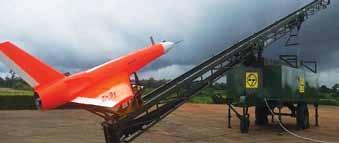
4 minute read
Air Defence
into enemy territory to increase the chance of a weapon solution on multiple and diverse targets.
The Resources. The IAF has a sanctioned strength of 42 combat squadrons and today the squadron strength is 30. Splitting this further would cause a dramatic drop in war waging potential. Flexibility and the ability to rapidly redeploy have been factored into plans, however, the challenges posed by recent military developments can best be thwarted by the present IAF plans which revolve around a coordinated offensive/ defensive philosophy of employment.
Advertisement
The Identification Dilemma. Another crucial function of an air defence system is that of Identification. This assumes even greater importance in a battle scenario. We need to understand that the air space is common for all air operations whether it is in own or enemy territory. The problem is compounded by the large radar field of view of our aircraft as well as the enhanced launch envelopes of the missiles. The coordination required is large and can be best achieved if the air operations are planned and controlled by one agency.
The present system also needs continuous upgradation as the IAF has no time to rest on its laurels. The force levels are woefully low and the emergency acquisition of third and fourth generation aircraft is a positive step. Rapid and accelerated crew training needs to be undertaken to make the pilots fully operational as quickly as possible. An area of deep concern is
Modernisation of Indian Air Force is transforming it
into an advanced network-centric force capable of sustained multi-role operations along the entire spectrum. L&T is proud to be a part of this transformation by contributing through the development of indigenous systems and technologies across domains – from Air Platforms to Air Defence.
L&T’s advanced electronics design & manufacturing facility at Bengaluru manufactures state-of-the-art avionic LRUs for LCA, ALH, LUH and LCH programs. These include Environmental Control and Fuel Management Control Unit (ECFM-EU),
Cockpit Interface Unit (CIU), Video Switching & Graphics Modules and Standby Engine Instrument (SEI). The company is also partnering DRDO in development of Integrated Life Support System (ILSS) with On-Board Oxygen Generation System (OBOGS), a technology available with only 5 countries worldwide.
Over three decades of collaboration with DRDO, ISRO and
DPSUs, L&T has pioneered the indigenous development of weapon delivery platforms, fire control systems, radars and airframes. L&T is partnering BDL and BEL for IAF’s AKASH
SAM system, in the manufacture of missile airframes, launchers and ROHINI radar systems. In collaboration with global OEMs, the company also offers Air Defence FCR and 3D-ASR systems.
Close-in weapon system SUDARSHAN is L&T’s latest
Indigenous offering for the IAF. The advanced air defence system, comprising Search & Fire Control Radars and Anti-
Aircraft Guns, is embedded with an Intelligent C2 system fully developed In-house, and can be integrated with existing surthe Nepal border. Chinese aircraft launched from Tibet can fly virtually undetected over Nepalese airspace and pose a serious threat to VA’s/VP’s in the Uttarakhand, Uttar Pradesh and Bihar.. The Chinese surface forces could use this route too. Once again, in this scenario the Offensive/Defensive employment strategy would work much more effectively.
IMPLICATIONS FOR NATIONAL SECURITY
With this concept, in one stroke we want to move back to segregating the air defence role from other air operations. The step would indeed be a folly of mammoth proportions and a Godsend for the enemy. The effects of such a move will directly impact India’s ability to wage an effective simultaneous offensive/defensive air war. Let us understand that surface forces on land can at best be used to impact the enemy targets within 30 kilometers of any boundary. It is only the IAF that from the beginning of a conflict, can impact the enemy deep inside his territory, destroy his war waging potential and will to fight. Air power must be utilised and the reluctance of leaders to apply air power, as it might be escalatory, should be dispensed with. Hit the enemy hard and be prepared to inflict more damage on the enemy when he retaliates. The proposed “Air Defence Command” needs to be viewed from the perspective of national interest. It is a retrograde step and if allowed, would become the biggest strategic military blunder for
INDIGENOus TEChNOlOGy - FORCE MulTIPlIER FOR ThE FORCEs
the Indian Armed Forces. SP
l&t’S IndIgenouSly develoPed manoeuvrable exPendable aerIal target undergoIng FlIght trIalS
veillance and AD assets. Besides, L&T’s JV with MBDA offers next-generation local and point missile air defence systems, anti-ship missiles and fifth-generation ATGMs.
Equipped with advanced R&D centres, L&T is aggressively foraying into development of futuristic technologies including Laser-based Directed Energy Weapons, AESA radar technologies like digital beam forming & wide band antenna array, unmanned platforms like tactical UAV and UCAV, counterdrone systems, and high-speed aerial targets. The company has invested in a network of world class dedicated defence manufacturing infrastructure across the country. L&T is focussed on developing indigenous solutions which can be seamlessly integrated with in-service systems and platforms to transform them into veritable force multipliers. SP










